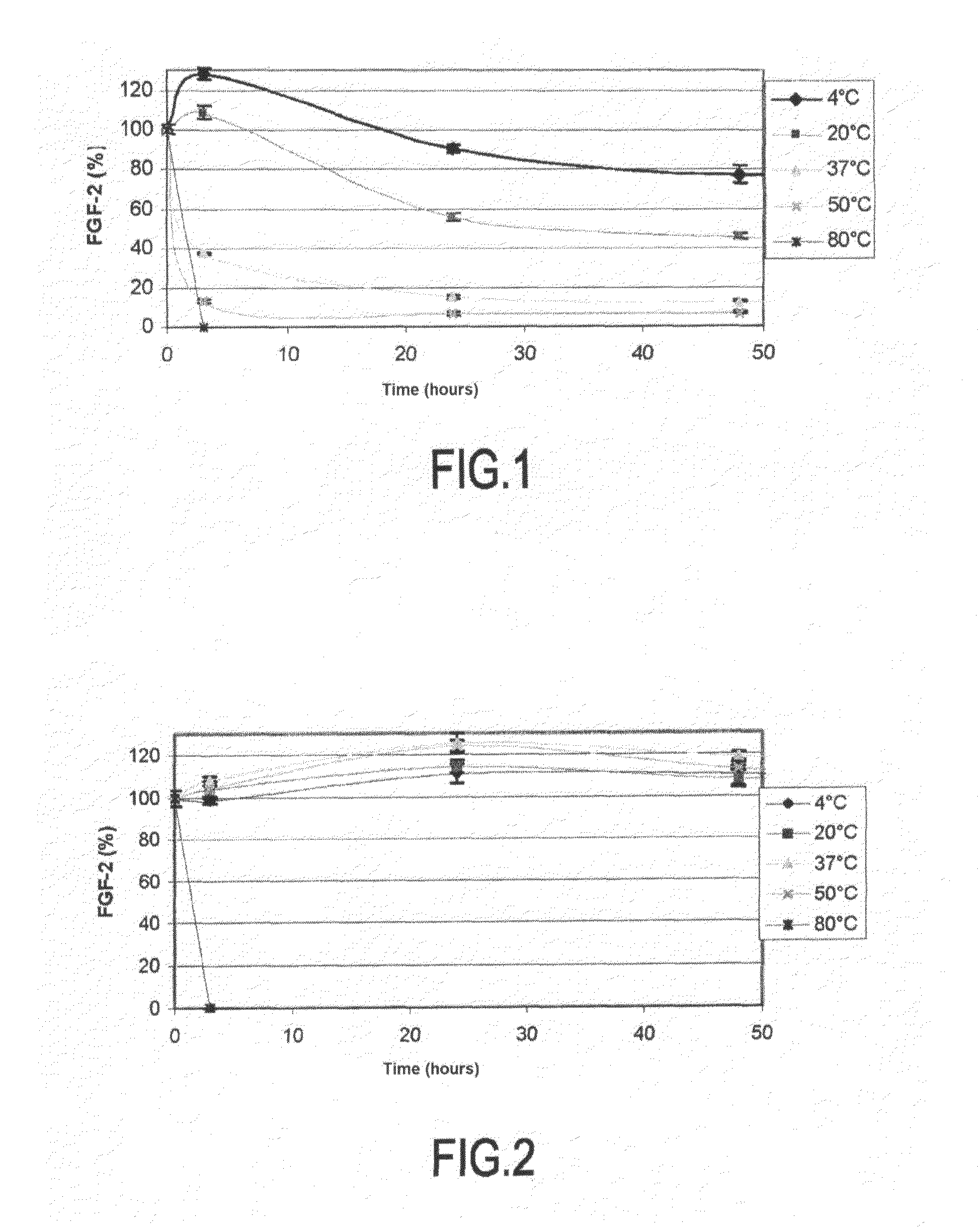Use of substances to protect FGF-2 or FGF-beta growth factor
- Summary
- Abstract
- Description
- Claims
- Application Information
AI Technical Summary
Benefits of technology
Problems solved by technology
Method used
Image
Examples
example 1
Study of Thermal Degradation of FGF-2
[0070]Tardieu et al, in 1992 studied thermal degradation of FGF-2 in a fibroblast proliferation model by radioactive element incorporation. The present inventors have developed a method with which the stability of FGF-2 may be investigated: this quantification method which may be used on a large scale, allows achievement of screening of active ingredients, which would not have been possible with the method described by Tardieu.
[0071]A 5 ng / ml solution of FGF-2 in a 10 mM PBS buffer with 0.1% BSA and 0.1% of methylparaben is prepared.
[0072]This solution is placed at various temperatures: 4° C., 20° C., 37° C., 50° C., and 80° C. either in the presence of heparin or not at 500 μg / ml.
[0073]Dosages of FGF-2 with a commercial ELISA kit (R&D system, France) are performed at different times (T=0, 3 hrs, 24 hrs and 48 hrs) so as to establish degradation kinetics for each temperature of investigation.
[0074]The results are expressed as a percentage of FGF-...
example 2
In Vitro Model for Selecting an Active Protecting FGF-2 Against Thermal Degradation
[0081]Degradation of FGF-2 observed at about 50° C. is particularly interesting, because a short period of time allows degradation of FGF-2 of about 80%, thereby allowing a large number of tests to be conducted. For this reason, it was decided to achieve screening with a stress of 2.15 hrs at 45° C. and to study the capacity of a large number of actives for protecting FGF-2 against this thermal degradation.
[0082]The applied screening model is the following:[0083]180 μl of a 4.5 ng / ml FGF-2 solution prepared in 0.1% BSA / PBS buffer are distributed in a 96-well microplate. 20 μl of distilled water or 0.05% heparin or a solution containing various active ingredients extracted from different plants to be tested are added. The plate is stirred by means of a plate stirrer and then covered with adhesive tape and placed in an oven at 45° C. for 2.15 hrs. At the end of the incubation period, the plate is taken...
example 3
Validation of the Model by GAGs and Proteoglycans of the Skin
[0086]Tests were carried out with commercially available GAGs and PGs in order to validate the model.
[0087]GAG solutions at different concentrations are made: heparan sulfate, dermatan sulfate, chondroitin sulfate, and hyaluronic acid are solubilized and tested at 0.1%, 0.01%, and 0.001%.
[0088]The heparin used as positive control is tested at 0.1%, 0.01%, 0.001%, 0.0001% and 0.00001%.
[0089]The tested proteoglycans are glypican-3 and decorin tested at 0.1%, 0.01%, and 0.001%.
[0090]The stress protocol described in Example 2 was applied, 20 μl of water being substituted with 20 μl of corresponding GAG or PG solution. The tested GAGs and PGs thereby undergo additional dilution to 1 / 10.
[0091]FIG. 3 illustrates the study of the FGF-2 protection by GAGs of the skin.
[0092]The results obtained in FIG. 3, confirm the data from the literature, i.e.:
[0093]Heparin sulfate protects FGF-2 as well as dermatan sulfate and this at each tes...
PUM
 Login to View More
Login to View More Abstract
Description
Claims
Application Information
 Login to View More
Login to View More - R&D
- Intellectual Property
- Life Sciences
- Materials
- Tech Scout
- Unparalleled Data Quality
- Higher Quality Content
- 60% Fewer Hallucinations
Browse by: Latest US Patents, China's latest patents, Technical Efficacy Thesaurus, Application Domain, Technology Topic, Popular Technical Reports.
© 2025 PatSnap. All rights reserved.Legal|Privacy policy|Modern Slavery Act Transparency Statement|Sitemap|About US| Contact US: help@patsnap.com



